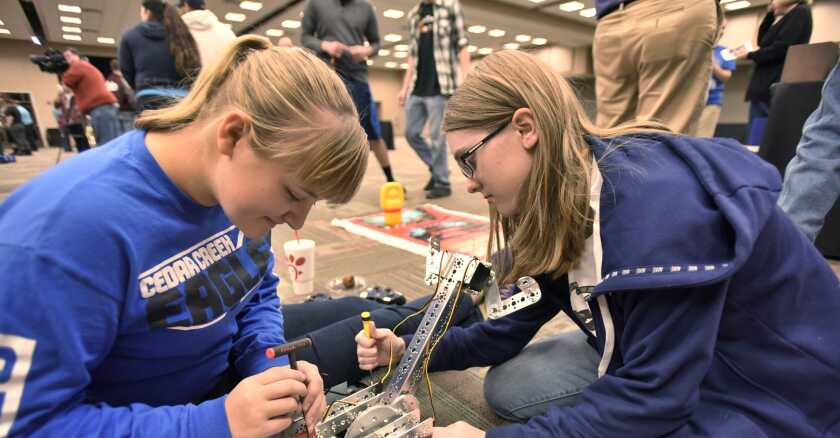Later in the week, Lewis is going to help her students use a 3-D printer at the back of the room to make their puzzles into something they could use and play with.
This process of imagining, creating and then building is how the new STEM (science, technology, engineering and math) curriculum six Bastrop district campuses have adopted this school year aims to foster engaging and exciting classroom environments.
The curriculum is designed by nonprofit Project Lead The Way, which has partnered with campuses across the nation to design more hands-on and problem-based STEM lessons for students from pre-K to high school.
“Research tells us and what we’ve seen is that when students see the connection between what they’re learning and how it helps them do something real, something that’s relevant, they get excited and they want to learn more — and they build confidence when they do that,” said David Dimmett, chief impact officer of Project Lead the Way, or PLTW.
The organization trains teachers to teach the curriculum and supplies schools with the materials needed for the lessons which are paid for through grants from NI, formerly National Instruments, an Austin-based company that sells testing equipment. Partnering and funding PLTW classes are part of NI’s community impact projects. It gave the Bastrop district a $60,000 grant to run the curriculum.
This is the first time the Bastrop district has adopted PLTW’s curriculum for grade levels below ninth grade. Bastrop High School has offered PLTW courses since 2015, and Cedar Creek High School since 2012.
The district’s director of career and military readiness, Amanda Brantley, attributed these classes as a factor for why alumni have matriculated to STEM programs in renowned universities such as Massachusetts Institute of Technology, the University of Texas and Texas A&M University.
“PLTW really sets students up to find future success, whether it’s engineering, whether it’s computer science, whether it’s something else, it gives them a space where they can really interact with what they’re learning about,” Brantley said.
The organization offers several programs for different grade levels which are designed to spark creativity that best suits the students’ age and interests. PLTW Launch is the program for elementary grades, which fosters the young student’s design-thinking mindset with activities and projects. For middle schoolers — a transitional phase for students — the program PLTW Gateway offers a space for them to explore and learn about their interests.
The Bastrop district schools that adopted PLTW this school year are: Bastrop Middle School, Cedar Creek Middle school, Bastrop Intermediate School, Cedar Creek Intermediate School, Cedar Creek Elementary and Red Rock Elementary. For middle school and high school students, taking a PLTW class is offered as an elective.
Tabitha Upshaw, senior director of brand reputation and impact at NI, said striving to diversify the pipeline of students going into STEM careers is why the company decided to partner with PLTW.
“One of the pillars of impact that we want to make is to change the faces of engineering, because the problem is that the engineering pipeline hasn’t changed much in the last 20 years,” she said.
Women make up just 28 percent of the STEM workforce, according to the American Association of University Women.
And there is a short window to catch young girls while they’re excited about science and math. A study by Microsoft, which surveyed around 11,500 girls in a dozen European countries, found that girls become interested in STEM subjects around 11 years old and quickly lose interest when they reach 15.
It also found that six in 10 girls admitted that they would be more confident to pursue careers in math and science if they knew men and women were already equally employed in those fields.
Upshaw said that PLTW is also working to boost the number of people of color in STEM fields, who according to the Pew Research Center are underrepresented in those careers. Black and Hispanic workers make up 11 percent and 17 percent, respectively, of STEM workforces, while white people make up 63 percent of the field, according to the study.
PLTW works to raise the number of girls and Black and Hispanic students in science and math workspaces by offering them a place to learn about those subjects early in their education while sitting next to their friends.
“As soon as middle school hits, it’s all about friends and the girls go where their friends go,” Upshaw said. “And so we’re looking at how we can target groups of girls — cliques of girls — and get them to take these classes.”
Lewis teaches PLTW’s curriculum, and her classroom is decorated with miniature robots and Lego posters — one being a playful version of the black-and-white Lunch Atop a Skyscraper photograph with Lego men.
Eighth graders Lucas Southwell and Lucca D’Amico have been friends since they were in elementary, and by chance, they were both placed in Lewis’ first period. They sit next to each other in class and get excited about transferring their blueprints to the online software, and soon, bringing it to life with the 3-D printer.
Southwell said the coolest part of the class is “the fact that we could design something that we could eventually be able to hold.”
D’Amico took the class because his older brother is part of the high school’s robotics team, and since he hopes to join the club when he’s older, he thought this class would help him learn more about engineering.
“Their robotics team is a bit understaffed, they have trouble finding people who are interested because not really a lot of people are interested in robotics,” said D’Amico, who hopes to work in animation. “So, I would like to go there and help them in the future next year.”
©2021 www.statesman.com. Distributed by Tribune Content Agency, LLC.









